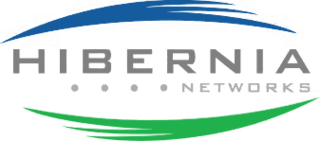The Eastern Africa Submarine Cable System (EASSy) is an undersea fibre optic cable system connecting countries in Eastern Africa to the rest of the world.

Hibernia Networks, alternately known as Hibernia Atlantic, was a privately held, US-owned provider of telecommunication services. It operated global network routes on self-healing rings in North America, Europe and Asia including submarine communications cable systems in the North Atlantic Ocean which connected Canada, the United States, the Republic of Ireland, the United Kingdom and mainland Europe. Hibernia managed cable landing stations in Dublin, Republic of Ireland; Coleraine, Northern Ireland; Southport, England; Halifax, Canada; Lynn, Massachusetts, United States.

South East Asia–Middle East–Western Europe 4 is an optical fibre submarine communications cable system that carries telecommunications between Singapore, Malaysia, Thailand, Bangladesh, India, Sri Lanka, Pakistan, United Arab Emirates, Saudi Arabia, Egypt, Italy, Tunisia, Algeria and France.
TGN Atlantic (TGN-A) previously VSNL Transatlantic and TGN Transatlantic, is a submarine telecommunications cable system transiting the Atlantic Ocean. The cable has been in operation since 2001.

The Internet in South Africa, one of the most technologically resourced countries on the African continent, is expanding. The internet country code top-level domain (ccTLD) .za is managed and regulated by the .za Domain Name Authority (.ZADNA) and was granted to South Africa by the Internet Corporation for Assigned Names and Numbers (ICANN) in 1990. Over 60% of Internet traffic generated on the African continent originates from South Africa. As of 2020, 41.5 million people were Internet users.
The Main One Cable is a submarine communications cable stretching from Portugal to South Africa with landings along the route in various west African countries. On April 28, 2008, it was announced that Main Street Technologies has awarded a turnkey supply contract for the Main One Cable System to Tyco Telecommunications.

The West Africa Cable System (WACS) is a submarine communications cable linking South Africa with the United Kingdom along the west coast of Africa that was constructed by Alcatel-Lucent. The cable consists of four fibre pairs and is 14,530 km in length, linking from Yzerfontein in the Western Cape of South Africa to London in the United Kingdom. It has 14 landing points, 12 along the western coast of Africa and 2 in Europe completed on land by a cable termination station in London. The total cost for the cable system is $650 million. WACS was originally known as the Africa West Coast Cable (AWCC) and was planned to branch to South America but this was dropped and the system eventually became the West African Cable System.
SAex is a proposed submarine communications cable linking South Africa to the United States with branches to Namibia, Saint Helena, and Brazil.
Pacific Fibre is a New Zealand-based company that proposed to build a trans-Pacific undersea communications cable that was to have competed with the Southern Cross Cable operated by Telecom New Zealand. The cable would have totalled 12,750 km in length, and the initial investment was projected to be US$350 million. Customers included Vodafone New Zealand, Australian ISP iiNet, and the Kiwi Advanced Research and Education Network in New Zealand.

WASACE was a planned system of submarine communications cables consisting of four sections with a total length of 29,000 km linking four continents.

The Caucasus Cable System is a Georgian-owned submarine communications cable in the Black Sea linking Poti, Georgia to Balchik, Bulgaria over a distance of 1,182 km. Its landing station in Balchik is connected to Frankfurt, Germany and other European Internet hubs via terrestrial connection. As the only communications cable linking Georgia directly to Europe, the Caucasus Cable System is deemed of geostrategic importance and has been at the center of controversy due to alleged plans to sell it to a Russian-owned company. As of January 2017 the cable is still in sole ownership of Caucasus Online.
South East Asia–Middle East–Western Europe 5 is an optical fibre submarine communications cable system that carries telecommunications between Singapore and France.

The South Atlantic Inter Link (SAIL) is a submarine communications cable in the South Atlantic Ocean linking Kribi, Cameroon with Fortaleza, Brazil.
The BRICS Cable was a planned optical fibre submarine communications cable system that would have carried telecommunications between the BRICS countries, specifically Brazil, Russia, India, China and South Africa. The cable was announced in 2012 but the project was abandoned around 2015. The project aimed to provide bandwidth around the Southern Hemisphere of the globe and to "ensure that developing nations’ communications are not all in the hands of the nations of the North".
Hibernia Express is a submarine communications cable system that was privately owned by Hibernia Networks, linking Canada, Ireland, and the UK. Hibernia Express is now owned by telecommunications provider GTT Communications, Inc. after their acquisition of Hibernia Networks. With a latency of 58.95ms, the cable currently provides the lowest latency fiber optic route between the NY4 data center in Secaucus, New Jersey and London.

Nicole Starosielski is an American author, researcher, and professor at the University of California, Berkeley. She conducts research on global internet and media distribution, communications infrastructures ranging from data centers to undersea cables, and media’s environmental and elemental dimensions.
Dunant is a private 250 Tbit/s 6,600 kilometre transatlantic communications cable that connects the United States with France (Saint-Hilaire-de-Riez). Named for Henry Dunant, it was announced by Google in 2018 and went live in 2020.
Amitié is a private transatlantic communications cable that connects the United States (Lynn), with the UK (Bude) and France. It was announced in 2020 and went live in October 2023. In 2023, EXA Infrastructure added Amitié to its transatlantic subsea cable route network connecting USA and Europe.
The Oman Australia Cable (OAC) is a 9,800 km fibre-optic submarine communications cable that entered service in September 2022, linking Oman and Australia via the Cocos (Keeling) Islands. The cable consists of three fibre pairs and had an initial design capacity of 39 terabits per second.








